2011 Hyundai Accent coolant level
[x] Cancel search: coolant levelPage 10 of 232
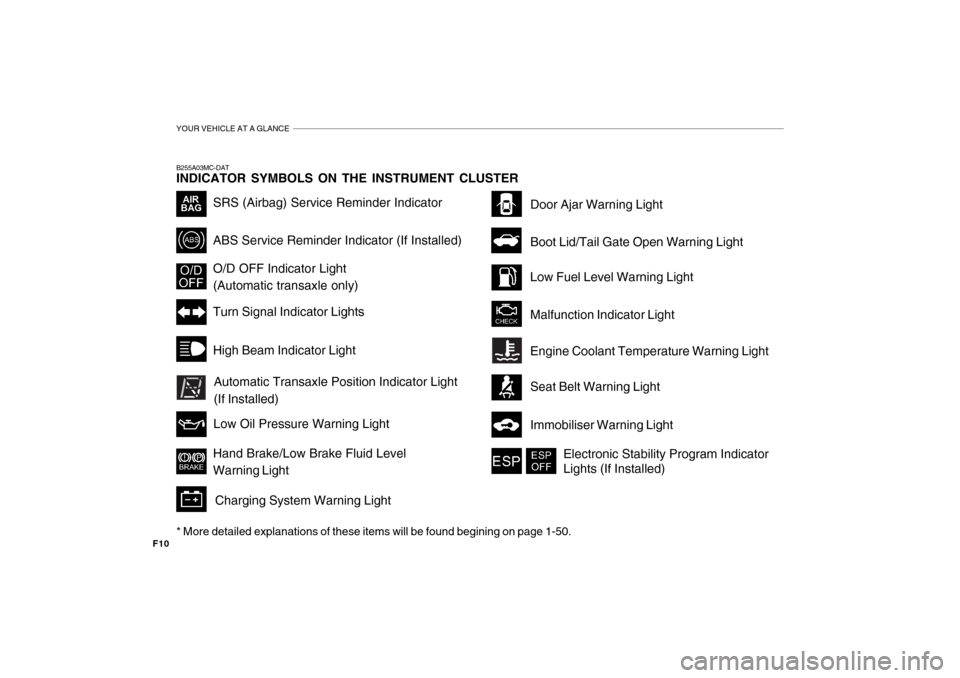
YOUR VEHICLE AT A GLANCE
F10B255A03MC-DAT INDICATOR SYMBOLS ON THE INSTRUMENT CLUSTER * More detailed explanations of these items will be found begining on page 1-50.
Turn Signal Indicator Lights
SRS (Airbag) Service Reminder Indicator O/D OFF Indicator Light (Automatic transaxle only) High Beam Indicator Light
Low Oil Pressure Warning Light
ABS Service Reminder Indicator (If Installed)
Door Ajar Warning Light
Hand Brake/Low Brake Fluid Level Warning Light Charging System Warning Light Low Fuel Level Warning Light Malfunction Indicator Light
Immobiliser Warning Light
Boot Lid/Tail Gate Open Warning Light
Engine Coolant Temperature Warning Light Seat Belt Warning Light
Electronic Stability Program Indicator Lights (If Installed)
Automatic Transaxle Position Indicator Light (If Installed)
Page 58 of 232
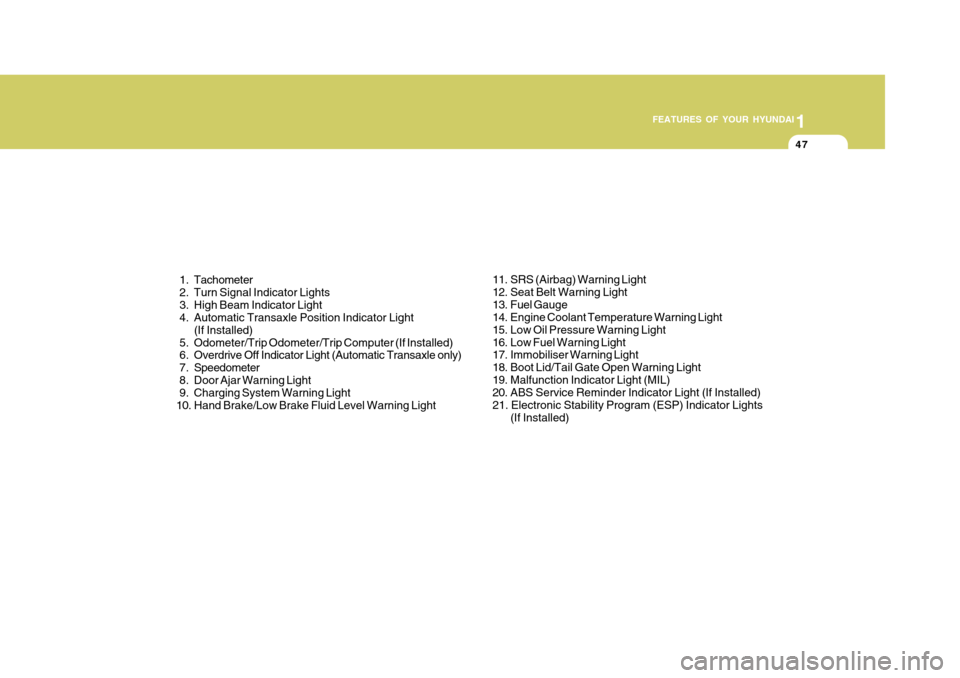
1
FEATURES OF YOUR HYUNDAI
47
1. Tachometer
2. Turn Signal Indicator Lights
3. High Beam Indicator Light
4. Automatic Transaxle Position Indicator Light (If Installed)
5. Odometer/Trip Odometer/Trip Computer (If Installed)
6. Overdrive Off Indicator Light (Automatic Transaxle only)
7. Speedometer
8. Door Ajar Warning Light
9. Charging System Warning Light
10. Hand Brake/Low Brake Fluid Level Warning Light 11. SRS (Airbag) Warning Light
12. Seat Belt Warning Light
13. Fuel Gauge
14. Engine Coolant Temperature Warning Light
15. Low Oil Pressure Warning Light
16. Low Fuel Warning Light
17. Immobiliser Warning Light
18. Boot Lid/Tail Gate Open Warning Light
19. Malfunction Indicator Light (MIL)
20. ABS Service Reminder Indicator Light (If Installed) 21. Electronic Stability Program (ESP) Indicator Lights
(If Installed)
Page 60 of 232
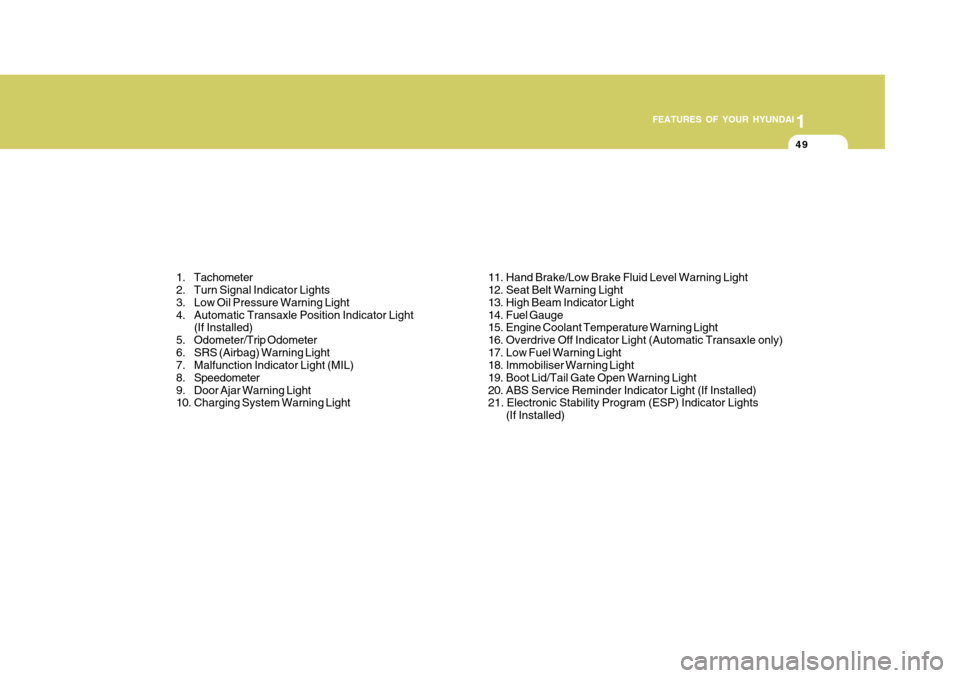
1
FEATURES OF YOUR HYUNDAI
49
1. Tachometer
2. Turn Signal Indicator Lights
3. Low Oil Pressure Warning Light
4. Automatic Transaxle Position Indicator Light (If Installed)
5. Odometer/Trip Odometer
6. SRS (Airbag) Warning Light
7. Malfunction Indicator Light (MIL)
8. Speedometer
9. Door Ajar Warning Light
10. Charging System Warning Light 11. Hand Brake/Low Brake Fluid Level Warning Light
12. Seat Belt Warning Light
13. High Beam Indicator Light
14. Fuel Gauge
15. Engine Coolant Temperature Warning Light
16. Overdrive Off Indicator Light (Automatic Transaxle only)
17. Low Fuel Warning Light
18. Immobiliser Warning Light
19. Boot Lid/Tail Gate Open Warning Light
20. ABS Service Reminder Indicator Light (If Installed) 21. Electronic Stability Program (ESP) Indicator Lights
(If Installed)
Page 64 of 232

1
FEATURES OF YOUR HYUNDAI
53
If the Emission Control System Mal- function Indicator Light begins toflash ON and OFF, potential catalytic converter damage is possible which could result in loss of engine power.Have the Engine Control System in- spected as soon as possible by an authorised Hyundai dealer.
B260N01MC-DAT Malfunction Indicator Light
This light illuminates when there is a malfunction of an exhaust gas relatedcomponent, and the system is not func- tioning properly so that the exha ust gas
regulation values are not satisfied. This light will also illuminate when the ignition
key is turned to the "ON" position, and then it will go out in a few seconds after
the engine is started. If it illuminates
while driving, or does not illuminate whenthe ignition key is turned to the "ON"position, take your car to your nearest
authorised Hyundai dealer and have the system checked.
CAUTION:
Prolonged driving with the Emis- sion Control System Malfunction Indicator Light illuminated may cause damage to the emission con-trol systems which could effect drivability or fuel economy.!
B290A02MC-DAT Engine Coolant Tempera-
ture Warning Light
warning:
Never remove the radiator cap when the engine is hot. The engine coolant is under pressure and could erupt and cause severe burns. Wait untilthe engine is cool before removing the radiator cap.
!
This warning light shows the tempera- ture of the engine coolant when the ignition switch is ON. The warning light illuminates if the temperature of theengine coolant is above 123±3°C (253.4±5.4°F). If the warning light illuminates, pull overand stop as soon as possible and turn off the engine. Then open the bonnet and check the coolant level (See "If theengine overheats" on the page 3-4.) and the water pump drive belt. If you sus- pect cooling system trouble, have yourcooling system checked by a Hyundai dealer as soon as possible.
Page 146 of 232
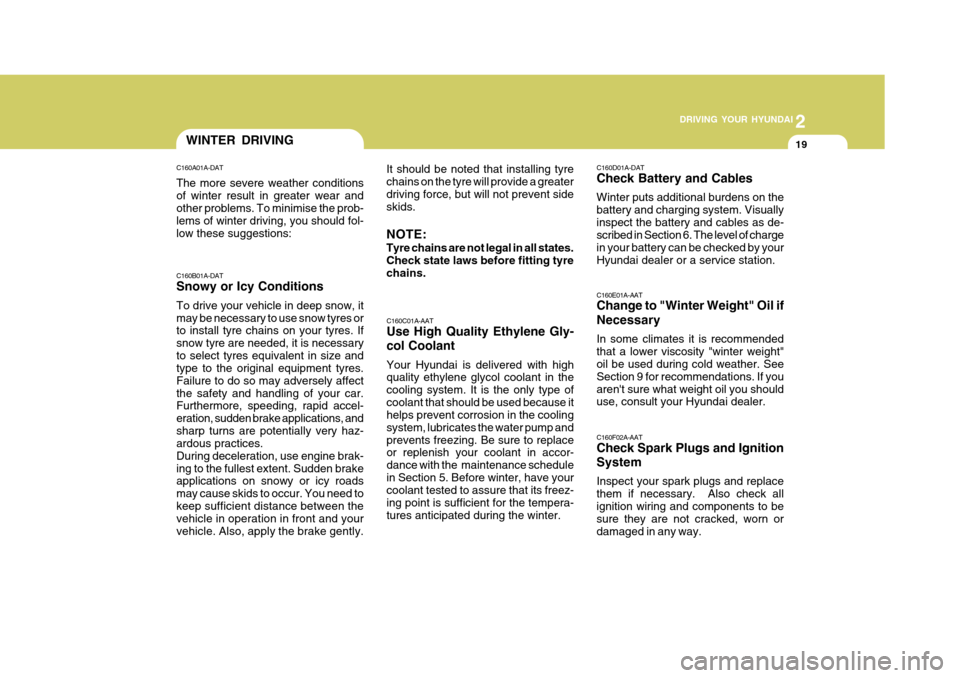
2
DRIVING YOUR HYUNDAI
19
2
DRIVING YOUR HYUNDAI
19
C160C01A-AAT Use High Quality Ethylene Gly- col Coolant Your Hyundai is delivered with high quality ethylene glycol coolant in the cooling system. It is the only type ofcoolant that should be used because it helps prevent corrosion in the cooling system, lubricates the water pump andprevents freezing. Be sure to replace or replenish your coolant in accor- dance with the maintenance schedulein Section 5. Before winter, have your coolant tested to assure that its freez- ing point is sufficient for the tempera-tures anticipated during the winter.
It should be noted that installing tyrechains on the tyre will provide a greaterdriving force, but will not prevent side skids. NOTE: Tyre chains are not legal in all states. Check state laws before fitting tyrechains.WINTER DRIVING
C160B01A-DAT Snowy or Icy Conditions To drive your vehicle in deep snow, it may be necessary to use snow tyres or to install tyre chains on your tyres. If snow tyre are needed, it is necessaryto select tyres equivalent in size and type to the original equipment tyres. Failure to do so may adversely affectthe safety and handling of your car. Furthermore, speeding, rapid accel- eration, sudden brake applications, andsharp turns are potentially very haz- ardous practices. During deceleration, use engine brak-ing to the fullest extent. Sudden brake applications on snowy or icy roads may cause skids to occur. You need to
keep sufficient distance between the vehicle in operation in front and your vehicle. Also, apply the brake gently.
C160A01A-DAT The more severe weather conditions of winter result in greater wear and other problems. To minimise the prob- lems of winter driving, you should fol-low these suggestions:
C160F02A-AAT Check Spark Plugs and Ignition System Inspect your spark plugs and replace them if necessary. Also check allignition wiring and components to be sure they are not cracked, worn or damaged in any way.
C160E01A-AAT Change to "Winter Weight" Oil if Necessary In some climates it is recommended that a lower viscosity "winter weight" oil be used during cold weather. See Section 9 for recommendations. If youaren't sure what weight oil you should use, consult your Hyundai dealer.
C160D01A-DAT Check Battery and Cables Winter puts additional burdens on the battery and charging system. Visuallyinspect the battery and cables as de- scribed in Section 6. The level of charge in your battery can be checked by yourHyundai dealer or a service station.
Page 157 of 232
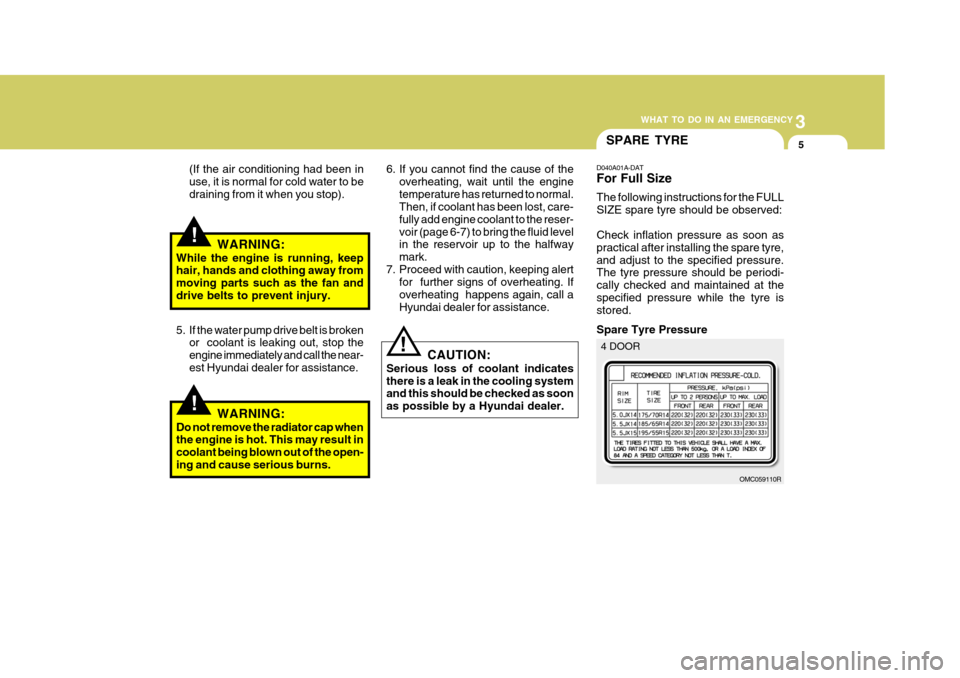
3
WHAT TO DO IN AN EMERGENCY
5
!
!
SPARE TYRE
(If the air conditioning had been in use, it is normal for cold water to bedraining from it when you stop).
WARNING:
While the engine is running, keep hair, hands and clothing away from moving parts such as the fan anddrive belts to prevent injury. 6. If you cannot find the cause of the
overheating, wait until the enginetemperature has returned to normal. Then, if coolant has been lost, care- fully add engine coolant to the reser-voir (page 6-7) to bring the fluid level in the reservoir up to the halfway mark.
7. Proceed with caution, keeping alert for further signs of overheating. Ifoverheating happens again, call aHyundai dealer for assistance.
5. If the water pump drive belt is broken or coolant is leaking out, stop theengine immediately and call the near-est Hyundai dealer for assistance.
WARNING:
Do not remove the radiator cap when the engine is hot. This may result in coolant being blown out of the open-ing and cause serious burns.
! CAUTION:
Serious loss of coolant indicates there is a leak in the cooling system and this should be checked as soon as possible by a Hyundai dealer. D040A01A-DAT For Full Size The following instructions for the FULL SIZE spare tyre should be observed: Check inflation pressure as soon as practical after installing the spare tyre,and adjust to the specified pressure. The tyre pressure should be periodi- cally checked and maintained at thespecified pressure while the tyre is stored. Spare Tyre Pressure
OMC059110R
4 DOOR
Page 180 of 232
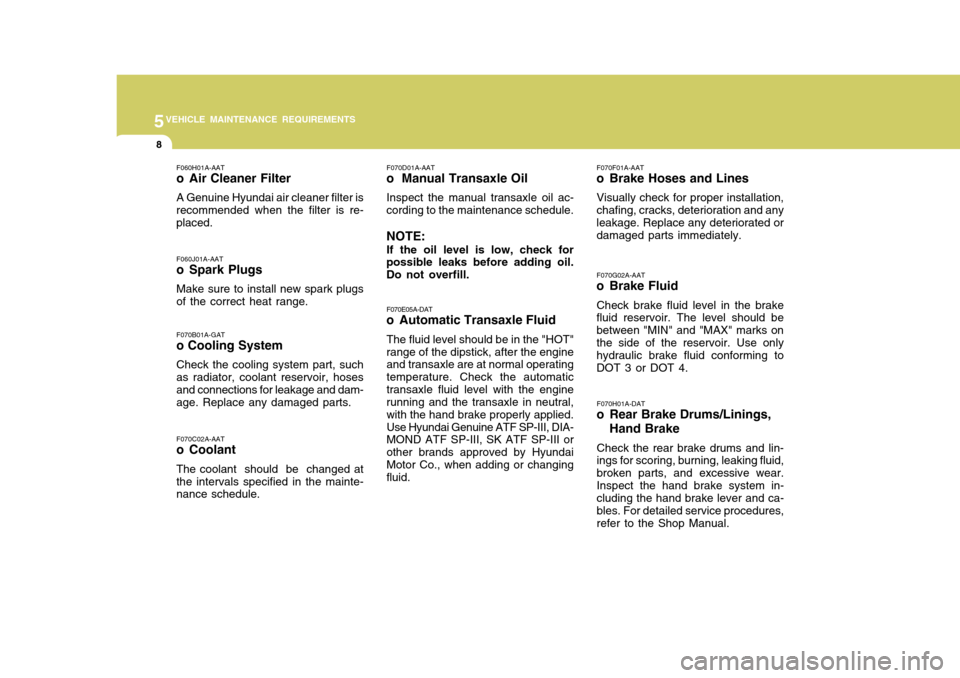
5VEHICLE MAINTENANCE REQUIREMENTS
8
F070H01A-DAT
o Rear Brake Drums/Linings,
Hand Brake
Check the rear brake drums and lin- ings for scoring, burning, leaking fluid, broken parts, and excessive wear.Inspect the hand brake system in- cluding the hand brake lever and ca- bles. For detailed service procedures,refer to the Shop Manual.
F060H01A-AAT
o Air Cleaner Filter A Genuine Hyundai air cleaner filter is recommended when the filter is re- placed. F060J01A-AAT
o Spark Plugs Make sure to install new spark plugs of the correct heat range. F070C02A-AAT
o Coolant The coolant should be changed at the intervals specified in the mainte- nance schedule.
F070E05A-DAT
o Automatic Transaxle Fluid
The fluid level should be in the "HOT" range of the dipstick, after the engine and transaxle are at normal operating temperature. Check the automatictransaxle fluid level with the engine running and the transaxle in neutral, with the hand brake properly applied.Use Hyundai Genuine ATF SP-III, DIA- MOND ATF SP-III, SK ATF SP-III or other brands approved by HyundaiMotor Co., when adding or changing fluid. F070F01A-AAT
o Brake Hoses and Lines
Visually check for proper installation, chafing, cracks, deterioration and any leakage. Replace any deteriorated or damaged parts immediately. F070G02A-AAT
o Brake Fluid
Check brake fluid level in the brake fluid reservoir. The level should be between "MIN" and "MAX" marks onthe side of the reservoir. Use only hydraulic brake fluid conforming to DOT 3 or DOT 4.
F070B01A-GAT o Cooling System Check the cooling system part, such as radiator, coolant reservoir, hoses and connections for leakage and dam- age. Replace any damaged parts. F070D01A-AAT
o Manual Transaxle Oil
Inspect the manual transaxle oil ac-
cording to the maintenance schedule. NOTE:
If the oil level is low, check for
possible leaks before adding oil. Do not overfill.
Page 182 of 232
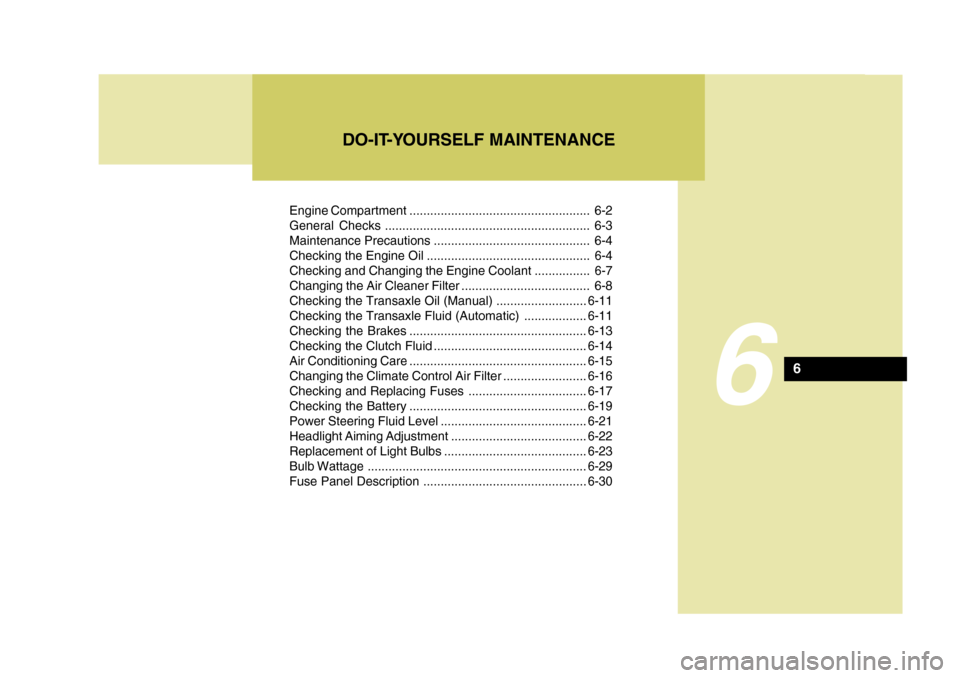
Engine Compartment .................................................... 6-2
General Checks ........................................................... 6-3
Maintenance Precautions ............................................. 6-4
Checking the Engine Oil ............................................... 6-4
Checking and Changing the Engine Coolant ................ 6-7
Changing the Air Cleaner Filter ..................................... 6-8
Checking the Transaxle Oil (Manual) ..........................6-11
Checking the Transaxle Fluid (Automatic)..................6-11
Checking the B rakes ................................................... 6-13
Checking the Clutch Fluid ............................................ 6-14
Air Conditioning Care ................................................... 6-15
Changing the Climate Control Air Filter........................ 6-16
Checking and Replacing Fuses .................................. 6-17
Checking the Battery ................................................... 6-19
Power Steering Fluid Level .......................................... 6-21
Headlight Aiming Adjustment ....................................... 6-22
Replacement of Light Bulbs ......................................... 6-23
Bulb Wattage ............................................................... 6-29
Fuse Panel Description ............................................... 6-30
DO-IT-YOURSELF MAINTENANCE
6
6